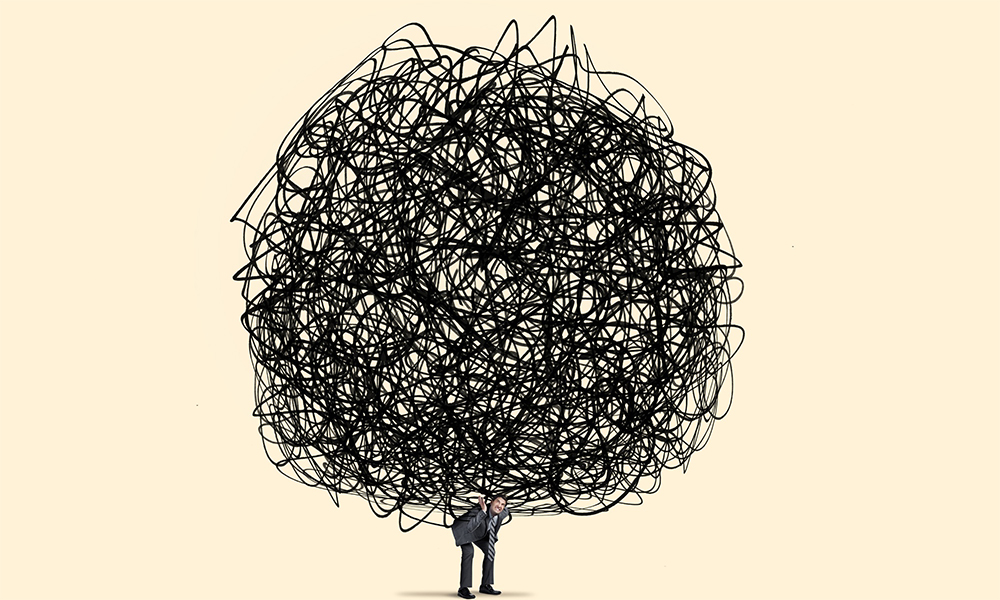Collaboration is viewed as a key imperative today. And for good reason. Research shows that the time spent in collaboration has jumped by over 50 percent in the last two decades. As companies get more global and cross functional, effective collaboration is necessary for success.
However, can collaboration become a bottleneck? This week my message focuses on how we can avoid collaboration overload – as individual employees, as leaders and as a company. How can we leverage the undeniable advantages of collaboration without the inefficiencies and fatigue that could come with it?
At the individual level
If you feel drained by the demands of emails, meetings and phone calls, you’re far from alone. With skyrocketing complexity and 24/7 connectivity, a majority of managers now spend more than 85 percent of their time on collaborative activities – leaving little space for independent deep work, reflection and decision-making. Instead of being a constant collaborator, why not become an efficient collaborator? Here are three suggestions to help you reclaim your time and purpose:
1. Examine your mindset
While collaboration overload is partly a function of today’s corporate culture, researchers have found that it’s also driven by an individual’s mindset.
Do you accept collaborative work above and beyond your capacity? If yes, why? Do you crave accomplishment, influence or a reputation for being helpful? Do you have FOMO (fear of missing out) when it comes to group discussions and initiatives?
Do you have trouble handing over control of projects you previously managed? In the Harvard Business Review article, Collaboration Without Burnout, the authors give an example:
For example, someone who engages in the entire life cycle of a small project, beyond the time when the need for her expertise has passed, might pride herself on supporting teammates and ensuring a high-quality result. But that’s not the kind of collaboration that makes a difference over the long term; indeed, too much of it will prevent her from doing more-important work.
Once you understand why you’re taking on too much collaborative work, you can revise your mindset to match your priorities. For example, if wanting to maintain a reputation for helpfulness is taking a toll on your key career goals, then it’s time to take a step back, learn to say “no” to non-essential tasks and protect your time for valuable work.
2. Tighten your schedule
Efficient collaborators are proactive, rather than reactive, taking charge of their own time and energy. Start by examining your schedule for recurring group activities that aren’t aligned with your personal expertise, values and goals – these can be eliminated. Also identify decision-making procedures that don’t really benefit from your involvement. If you’re not adding unique value, why spend your precious time on it? Be sure to share your revised expectations with colleagues. Tell them about your priorities so they know what you want to spend your time on and can approach you with the right kind of requests.
3. Pass it on
If there’s an exciting collaborative project that doesn’t line up with your personal strengths/priorities, ask yourself if another colleague might be more suitable for it. Could it be a fantastic opportunity for them? In the Harvard Business Review article mentioned above, the authors say:
Ask colleagues about their interests and ambitions so that you can identify opportunities to distribute or delegate work. A key inflection point for all the executives we’ve counseled has been when they start seeing requests for collaboration as ways to activate and engage those in their networks rather than as adding to their own to-do lists.
At the leadership level
Here are five recommendations to help leaders avoid excessive, unproductive collaboration:
1. Choose participants thoughtfully
In How Managers Can Make Group Projects More Efficient, Amy Jen Su explains:
It can be tempting to want to include everyone on a project, but if you’re the lead of a team or meeting, you need to be thoughtful about who is in the room. Bring together the people who are closest to the problem – those who understand the issue at the root level. Be clear about who is coming and why.
As leaders, we can’t replace effective communication with meetings. Don’t invite the entire team to every single discussion just so they stay in the loop – this is a highly ineffective use of everyone’s time. Find and implement other ways of sharing vital updates, so people can get on with their work while still staying informed.
2. Do the homework
When leading a meeting, respect other people’s time by being prepared. What is the purpose and agenda of the meeting? Is it meant to be an open-ended brainstorm or are you asking for feedback on a plan you’ve already created? Send out a clear agenda and any readings at least 24 hours in advance, so invitees know their role and what is expected of them.
3. Acknowledge ownership
When the moment arrives, who will make the final call? Who will decide on the trade-offs? If it’s going to be put to a vote, who will be the tiebreaker? As the leader, you need to share these answers with the group. In the article mentioned above, Jen Su explains that ambiguity around decision-making makes collaboration messy, slow and prone to conflict. She advises leaders to create clarity right from the start:
While it’s important that you hear out and value others’ perspectives, the reality is that not everything is or should be a consensus-based decision. If you’re going to make the final decision, tell people that up front. You can’t get people fired up and excited only to have them find out afterward that you had 51% of the vote….
4. Set a “meeting budget”
First, calculate the amount of time your team spends in meetings. Then, come up with an acceptable weekly limit – this is your meeting budget. When someone requests a new meeting, remind them that it’s coming out of the pre-allocated hours (a good way to make people think twice about the purpose and duration of the discussion). Once the budget is used up, entertain only crucial requests. Over time, the use of a meeting budget creates a tighter, more efficient collaborative culture. Enact this step with the buy-in of your team – while there may be some wrinkles to iron out, I promise they’ll be happy to work towards reducing time spent in meetings!
5. Don’t overburden “extra milers”
In 3 Signs You’re Suffering From Collaborative Burnout, Ilan Mochari warns against the tendency to over-rely on extra-milers – top performers who tend to be given the lion’s share of collaborative work. Mochari advises leaders to reduce the burden shouldered by this small, crucial set of employees:
First, redefine their roles to relieve them of (some of) their draining tasks. Second, hire or reassign others to handle those less essential duties.
At the organisational level
While individuals and leaders can definitely improve collaboration, the company culture itself may also require changes. Keep an eye out for these two organisational red flags:
1. When meetings become the unquestioned norm
In Collaboration Overload Is a Symptom of a Deeper Organizational Problem, Michael Mankins explains that if the organisational culture is built around attending meetings, individual employees can do little to curb the trend:
Over time, meetings become a status symbol-that is, the more meetings to which an executive is invited, the more important he or she is assumed to be.
2. When every decision involves an army
Mankins also highlights the process by which decisions are made. A complex model that requires various executives to participate in every key decision leads to a lot of unproductive collaboration. This organisational drag slows down decision-making and creates a sinkhole of wasted time. By simplifying processes and getting innovative, companies can free up these precious hours. Mankins gives the example of a creative change introduced by the multinational brewing company, AB InBev:
All senior executives at AB InBev work around a common conference table. Supply chain leaders are expected to interact with marketers, for example, to solve complex problems in real time rather than rely on armies of subordinates and hours of review meetings. By streamlining the operating model, AB InBev dramatically reduced the number of interactions required to get work done, reducing costs and accelerating decision making and execution.








Comments